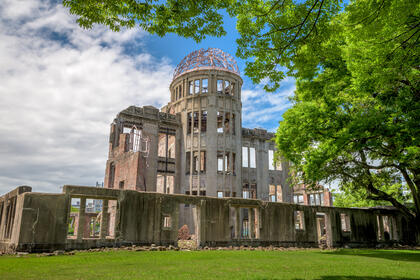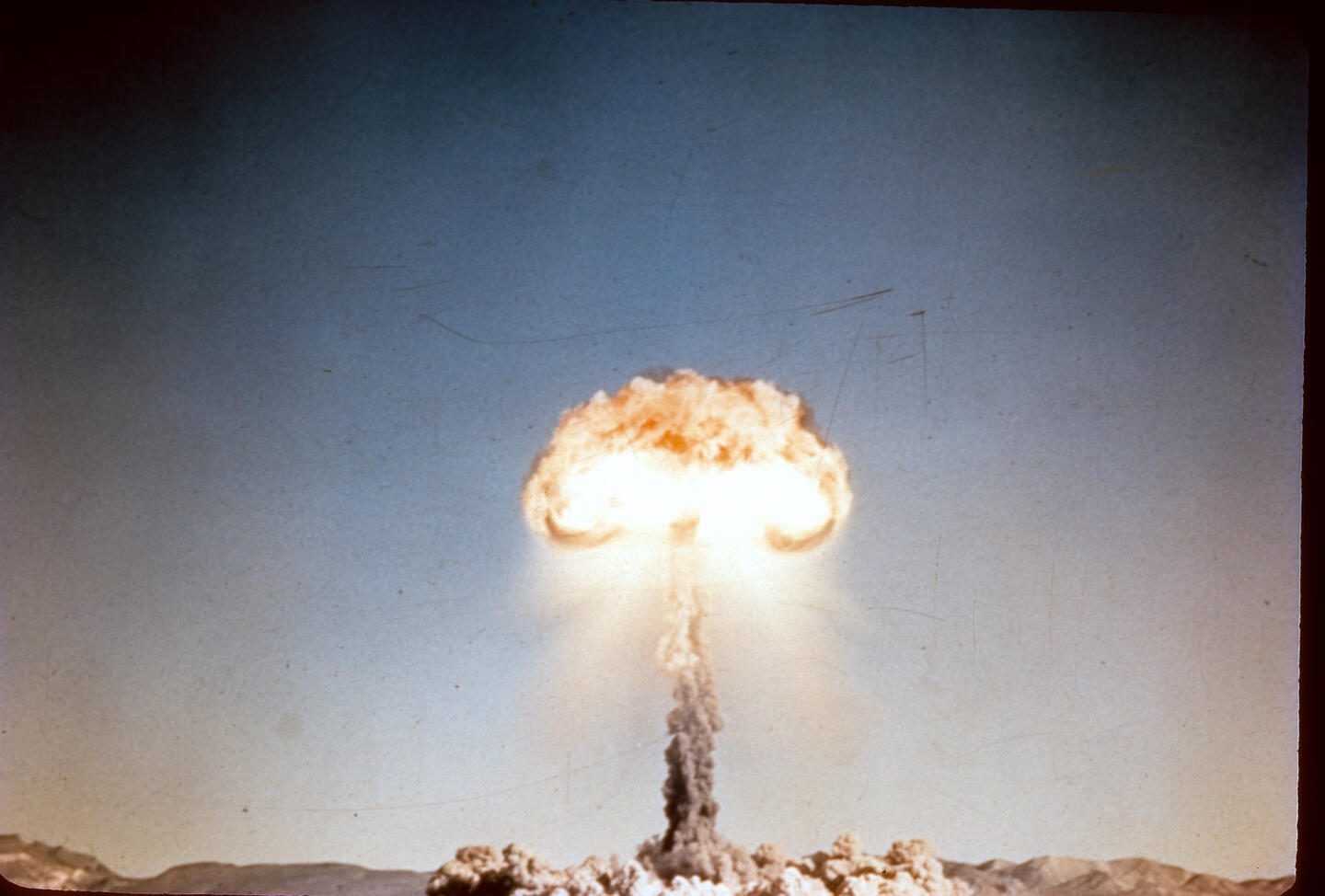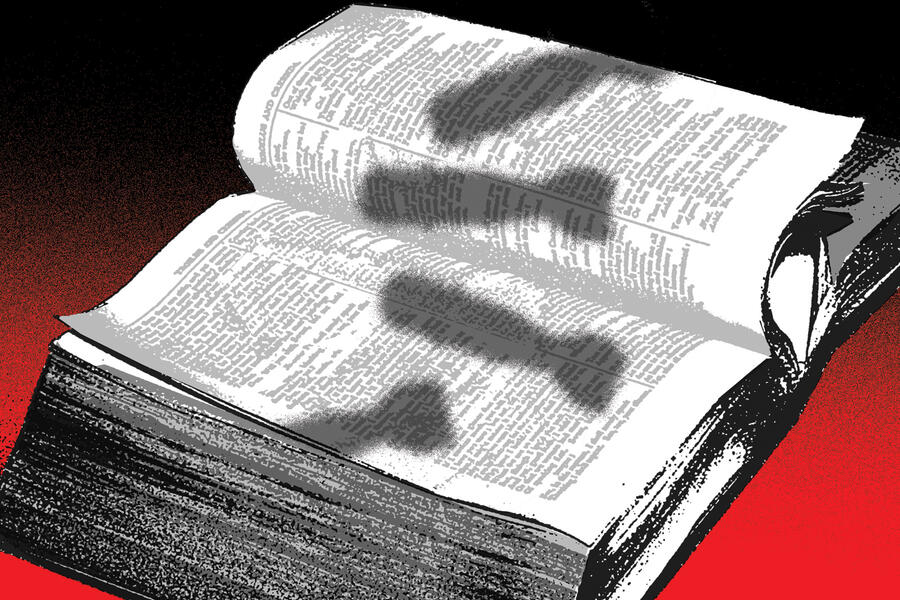Many Americans—including students in the History of the Atomic Bomb course taught at the University of Texas at Austin by Bruce J. Hunt, A&S '84 (PhD)—have learned a version of this story:
On Aug. 6, 1945, the American B-29 bomber Enola Gay dropped an atomic bomb on Hiroshima, Japan. Three days later, the United States dropped a second A-bomb on Nagasaki. The decision to authorize such destructive force rested with President Truman, but he had little choice: The bomb enabled the United States to avoid a ground invasion of the island empire, a strategy that would have cost hundreds of thousands of U.S. lives and killed far more Japanese than the 100,000 to 250,000 who died in the blasts. It was the only way to force Japan to surrender.
Eighty years after the United States became the only nation in history to use nuclear weapons against an adversary, this straightforward account reflects many Americans' beliefs about the event. "I don't want to say it's totally false," says Hunt, a professor of history at UT Austin. "It has large elements of validity in it, which has made it more saleable." But it's an oversimplified narrative that leaves out factors including the Soviet Union's declaration of war on Japan; U.S. concerns about postwar relations with the Soviets; dynamics within both the Japanese and American governments; and, of course, the ethics of killing so many civilians.
Image caption: Eighty years after the U.S. dropped atomic bombs on the Japanese cities of Hiroshima and Nagasaki, survivors continue to warn against the use of nuclear weapons
Video credit: BBC News
In the U.S., attempts to reckon with the events of August 1945 often have been met with backlash and a reluctance to consider the bomb's deployment as anything other than inevitable. But an inaccurate public understanding of the nuclear past can, like any counterfactual belief, misdirect policy in the present.
For Hunt, the story of the atomic bomb is a case of public memory—what people believe happened in the past and what it means to them—supplanting the actual events of history. That memory "is quite deliberately shaped sometimes," he says. "I think the atomic bomb story is one of a real campaign of cementing, in the public mind, a particular understanding of what happened."
Hunt's work, and that of other Hopkins affiliated scholars, illuminates a more complex narrative about America's nuclear past and makes the case for rethinking one of the most consequential episodes in history.
For nearly 40 years, Hunt has pushed his UT students—history majors as well as students in engineering, natural sciences, and liberal arts—to interrogate public memory about the bomb. Although at times he's structured the course as an intimate 25-person writing-intensive class, recently he's presented it as a lecture that enrolls up to 150 students on the 52,000-student flagship campus. Hunt grew up in Walla Walla, Washington, about 75 miles from the Hanford Nuclear Reservation, where the plutonium for the Nagasaki bomb was produced. It was a region steeped in atomic iconography: His high school's rival team hailed from Richland, where many of the Hanford workers once lived, and was called the Richland Bombers. Football players' helmets sported an image of a bomb. Today, it's been replaced by a mushroom cloud.

Image caption: Bruce J. Hunt
Image credit: University of Texas at Austin
At the University of Washington, Hunt took a course about the history of the atomic bomb. After earning his doctorate from Johns Hopkins in the history of science, he launched his own course in 1986 after coming to UT Austin, where his research focuses on the history of cable telegraphy and electrical physics. His students read declassified documents: correspondence, scientific and government reports, and meeting minutes, such as those from the Interim Committee established in 1945 by Secretary of War Henry Stimson to discuss the wartime and postwar implications of nuclear technology. Most of the documents are available via the online National Security Archive hosted by George Washington University. "My real goal is to get students to look at primary sources and think through things for themselves," he says.
On a stormy February day, a C-SPAN team filmed his class for its Lectures in History series. Rain lashed against the windows in his classroom as the cameras rolled and Hunt told his students about the three secret cities built for the Manhattan Project in Oak Ridge, Tennessee; Hanford; and Los Alamos, New Mexico. Tens of thousands of workers in Oak Ridge enriched uranium for Little Boy, the bomb dropped on Hiroshima. At the Hanford site, more than 2,000 miles away, nuclear reactors produced plutonium for the Fat Man bomb dropped on Nagasaki. The Army, which oversaw the project of atomic bomb building, wanted to try multiple methods to ensure one would work. Most of the project's $2 billion budget, Hunt said, was spent at Oak Ridge, "even though, in the legend of the Manhattan Project, we think everything happened at Los Alamos," where the bombs were built. The 2023 film Oppenheimer likely reinforced this perception.
The "legend" is Hunt's shorthand for all the misconceptions fostered by pop culture and secondary school history class. To get closer to the truth, his students focus on sources stripped of layers of subsequent interpretation. Their primary assignment is a memo of advice to President Truman, written to be delivered in late July 1945 and based exclusively on information that would have been available at the time. The research process yields options beyond the binary choice to drop the bomb or sacrifice thousands of soldiers in a ground invasion. For example, in the May 31, 1945 Interim Committee meeting, the option of giving the Japanese advance warning was considered but rejected. A letter written by Manhattan Project physicist Ernest Lawrence, who attended the meeting, also references a discussion of conducting a demonstration bombing rather than dropping it on a city without warning. Manhattan Project scientists who contributed to a June 1945 publication called the Franck Report suggested demonstrating the bomb over an uninhabited area and warning the Japanese leadership that the weapons would be used on the mainland unless they surrendered.
Despite the legend's assertion that Truman actively chose to use the bombs, documents reveal that his role in decision-making was more limited. Truman knew no details about the development of the bomb until he became president after Roosevelt's death in April 1945, less than three months after he was sworn in as vice president. He was briefed later that month about the project, which was by then close to completion, and he evidently saw no reason to stop a project started under his predecessor. Only after Nagasaki did he give explicit instructions, telling the military to halt the campaign unless he authorized additional targets.
General Leslie Groves, who led the Manhattan Project, wrote in his memoir that "as far as I was concerned, his [Truman's] decision was one of noninterference—basically a decision not to upset the existing plans."
In his course paper, UT history major Theo Rosen urged the president to stage a nonlethal demonstration and, if Japan did not surrender, then drop atomic bombs on military targets. "I believe that showing the enemy the power of the bomb without destroying a city will induce them to accept surrender," he wrote.
Explaining his rationale in an interview, he added: "They could have chosen a much less populated target and still have this effect of, 'Wow, this is the most destructive weapon we've ever seen,' without killing as many people."
Because the Manhattan Project had been such a closely guarded secret, the American public was unprepared for President Truman's announcement on Aug. 6 that the military had used a new kind of weapon, "a harnessing of the basic power of the universe." The U.S. worked to shape public opinion about the bomb, Hunt says, partly by suppressing photos of the destruction and dismissing accounts of radiation sickness. A Gallup poll taken in the days after the bombings reported 85% approval of the attacks.
In 1946, New Yorker writer John Hersey, a war correspondent in the Pacific Theater, decided to interview people who had survived the bombing. The resulting story, the monumental "Hiroshima," wove together six survivors' accounts, from the blinding flash of the initial blast through the fires that followed, the gruesome injuries they witnessed, and their own radiation sickness. On Aug. 31, 1946, the magazine dedicated an entire issue to the story, which was subsequently printed as a book.
Hersey's account engendered sympathy for the suffering of the Japanese, but it did not prompt a significant public movement against nuclear weapons, Hunt says. Partly as a rebuttal to Hersey's reporting, Stimson and his advisers published "The Decision to Use the Atomic Bomb" in Harper's Magazine in February 1947. Stimson wrote that providing Japan with advance warning, or conducting a demonstration of the bomb, was impractical. He argued that once Japan had rejected the demand for unconditional surrender issued on July 26 by the leaders of the U.S., U.K., and China at Potsdam, the U.S. had no choice but to follow through with the declaration's threat of "inevitable and complete destruction."
Stimson's essay concluded: "With the release of atomic energy, man's ability to destroy himself is very nearly complete. The bombs dropped on Hiroshima and Nagasaki ended a war. They also made it wholly clear that we must never have another war."
Even before August 1945, scientists and government leaders, including Stimson, were considering a future in which the United States was not the only nuclear state. Many thought the solution was some sort of world government or organization that would control all nuclear material. "While the idea of a world government seems alien to us now, at that time, it didn't," says Daniel Deudney, a Johns Hopkins professor of political science who teaches the course Global Security Politics. Some people viewed the bomb as the next step in the evolution of weapons that had consistently increased the size of the militarily viable nation-state, Deudney says. Just as gunpowder had rendered the medieval fiefdom obsolete, nuclear weapons made even continental nations such as the United States and Soviet Union vulnerable.
"Nuclear one worldism" never became a reality, partly because it was difficult to answer the obvious question of how to guard against despotism in a one-world government's leadership. The idea faded as it became evident that neither the U.S. nor the Soviet Union, which tested its first nuclear bomb in 1949, wanted to cede control.
By the 1960s, the United States and the Soviet Union had settled into a posture of deterrence. "The key point of deterrence is that, as long as states view a nuclear war and the nuclear attack as essentially suicidal, they won't do it," Deudney says. After the Cuban Missile Crisis, the American and Soviet leadership, shaken by their brush with war, became more willing to pursue arms control. The nuclear buildup of the midcentury ultimately gave way to a reduction in arms in the early 1990s, as the two nations forged agreements to shrink their arsenals.
By the 1980s, scientists sounded alarms that nuclear war would not only wreak destruction on the antagonists but could render the Earth uninhabitable. In late 1994, Gallup administered the same poll it had conducted in August 1945, asking respondents whether they approved or disapproved of using the atomic bomb on Japanese cities. Nearly half a century later, only 55% approved.
Meanwhile, the Smithsonian's National Air and Space Museum was preparing to mount an exhibit featuring the restored Enola Gay to coincide with the 50th anniversary of the atomic bomb. In the exhibit, originally called The Crossroads: The End of World War II, the Atomic Bomb and the Origins of the Cold War, the plane would be the central artifact showcased amid discussion of the consequences for the Japanese and the subsequent nuclear arms race. This approach was emblematic of a shift then underway at the Smithsonian, says Art Molella, former Hopkins visiting professor and curator emeritus at the Smithsonian Institution's National Museum of American History. Historically, Molella says, Smithsonian exhibits about technology had focused on how inventions worked. But in the 1980s and 1990s, the museums widened their focus to the social meaning of technologies and considered them from multiple perspectives—which made the Smithsonian more vulnerable to push-back from people who didn't agree with its analysis.
Michael Neufeld, A&S '80 (MA), A&S '84 (PhD), was the exhibit's lead curator. He and his colleagues traveled to Hiroshima and Nagasaki and arranged to borrow artifacts, such as a schoolgirl's lunchbox that had been charred in the blast, and developed a script broadly accepted by historians outside the Smithsonian. The initial exhibit was divided into five sections: displays covering the last year of the war, including the U.S. naval blockade of Japan and firebombing of Japanese cities; the decision to drop the bomb (which made the case that Truman made no such decision); the delivery of the bomb by the Enola Gay and its crew; the destruction of Hiroshima, with graphic photos; and the beginnings of the Cold War. Throughout, text panels labeled "Historical controversies" posed questions: How important was the Soviet factor in the "decision to drop the bomb"? Was a warning or demonstration possible? Was an invasion inevitable if the atomic bomb had not been dropped? Was the decision to drop the bomb justified? Each question was followed by a brief analysis that summarized the scholarly consensus at the time.

Image caption: The Atomic Bomb Dome in Hiroshima Peace Memorial Park.
Image credit: Hanafujikan
But veterans' groups publicly criticized the planned exhibit for even posing such questions, a line of inquiry they viewed as unpatriotic. In a political climate characterized by accelerating culture wars, and in the leadup to the 1994 Republican Revolution in Congress, elected officials lambasted the script—which few, if any, had read—for being too sympathetic to the Japanese. Museum director Martin Harwit tried to negotiate with the veterans' groups, removing photos of damage at Hiroshima and adding references to Japanese atrocities, but historians condemned those changes. "We ended up with a vastly distorted exhibit," Neufeld said in a recorded interview at the National World War II Museum in 2023. The exhibit ultimately was canceled and replaced by a stripped-down display of the plane's fuselage.
The episode raised "deep questions—and they're very much on the minds of people at the Smithsonian right at this moment—of what the function of a museum like the Smithsonian is," says Hunt, who completed a postdoctoral fellowship at the Smithsonian's National Museum of American History before coming to UT Austin. "Is it to celebrate? Is it to analyze? Is it to commemorate? Or is it just to remember?"
In June of this year, the Pew Research Center surveyed American adults about whether they thought use of the atomic bomb on Japanese cities in 1945 was justified. Of the respondents, 35% said yes, 31% said no, and a third were unsure. The poll was structured and administered differently from Gallup's, but the results suggest support for the U.S.' actions has reached an all-time low.
Over the four decades Hunt has taught his course, he hasn't seen dramatic, generational shifts in his students' perspectives. What he does notice is that individual students' opinions evolve. In polls he administers a couple of times each semester, he asks the class if they think the U.S. should have bombed Japanese cities, bombed military targets, staged a demonstration of the bomb, issued a warning, or not used the bomb at all. The distribution of students who choose each option changes as they reevaluate their conclusions.
By the end of the course, the students are able to offer more reasoned arguments, Hunt says. Some of the primary sources conflict with one another, he adds, but reading those documents is "better than pulling ideas out of the air, or from some sense of what 'must have' been the case— or listening to people who have an agenda."
Most students today have grown up in a post– Cold War era that Deudney says is characterized by an elevated concern about nuclear materials falling into the hands of nonstate actors such as terrorist groups and cults, fears intensified by the Sept. 11 attacks and anthrax attacks that followed. The past three decades also have been marked by a radical approach to nonproliferation manifested in preemptive attacks by nuclear-armed nations on potential nuclear powers, such as the U.S. invasion of Iraq in 2003 and strikes by Israel and the U.S. on Iran this past summer.
Today, the nine countries with nuclear weapons wield significant geopolitical power without detonating a single bomb during war. Even the United States can be deterred from some actions by a much smaller nuclear-armed country. "If the United States is the most powerful nation in the world—with leading economic, conventional, and even soft power—states with nuclear weapons flatten that out," says Francis Gavin, the director of the Henry A. Kissinger Center for Global Affairs at JHU's School of Advanced International Studies.
Gavin likens the work of studying nuclear history and policy to living in a haunted house. "The house is world politics, and the ghost is nuclear weapons," he says. "You never really see it, but if it rattles and comes out, it scares the hell out of you, and if it's done that once, you never forget it. And even if you forget about the ghost for a while, you never fully sleep well at night."
The public, though, isn't losing much sleep over nuclear weapons, Deudney says. New threats, including environmental degradation, AI, and potential pandemics demand our attention. The energy of activists who might otherwise campaign for nuclear disarmament is largely focused on climate—that is, until a major milestone, like this year's 80th anniversary of the bombings, reminds people of the nuclear ghost and prompts reflection about the atomic bomb.

Image caption: Vintage 35mm slide scan of an atom bomb explosion and mushroom cloud in the desert.
Image credit: Dennis Swanson, Studio 101 West Photography / Getty Images
Does it matter if what most Americans know about the bomb is a legend that is, at best, partially true? Gavin says it does, for both political and personal reasons. Public opinion influences policymaking, and better policy emerges when public opinion is based on a sound understanding of facts.
On an individual level, it's easy for someone to opine in 2025 about how they could have made better choices than did U.S. leaders in 1945, Gavin says. But studying how American leaders evaluated their options and moved forward can be instructive, even if one doesn't agree with the outcome. "You'll make other decisions that will have similar moral complexity and have no clearcut answers," Gavin says. "That's why history is important. And it's never easy or simple."
Hunt launched his class during the Cold War and has taught it through the Enola Gay controversy, Pakistan's and North Korea's attainment of nuclear power, and the release of the blockbuster Oppenheimer. He will teach it once more next year before he retires. For Rosen, the course rounded out his understanding of August 1945 while inoculating him against other oversimplified historical narratives.
"Memory can change, and it can be shaped by powerful people," he says. "That is a constant battle for historians. The No. 1 reason why history as a discipline is important is to seek out the truth, and to make sure that the public knows the truth."
Posted in Science+Technology, Politics+Society, Alumni
Tagged american history








